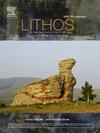Mantle metasomatism by subducted Indian continental crust: Evidence from post-collisional basaltic ultrapotassic rocks in southern Tibetan plateau
IF 2.9
2区 地球科学
Q2 GEOCHEMISTRY & GEOPHYSICS
引用次数: 0
Abstract
At continental collisional zones, the continental crust is known to subduct, penetrating the deep lithospheric mantle and undergoing partial melting. However, the extent to which these melts can effectively alter, or metasomatize, the overlying mantle remains a contentious issue. This debate is especially pronounced in the Cenozoic Himalayan-southern Tibet collisional orogen. The complexity arises from the fact that previous research has predominantly concentrated on the post-collisional intermediate ultrapotassic rocks. However, these rocks could have originated either from the subducted Indian continental crust through a process of mantle assimilation or from mélange rocks, thereby primarily reflecting crustal recycling rather than mantle metasomatism by subducted continental crust. In this study, we shift our focus to the less-well-studied post-collisional basaltic ultrapotassic rocks (BUPRs) from the Sailipu region in the Lhasa block of southern Tibet. Our aim is to evaluate the characteristics of the orogenic mantle and the dynamics of crust-mantle interactions. In this study we report major and trace elements and Sr-Nd-Pb-Mo-B isotopes for these Miocene post-collisional BUPRs. The rocks are typically characterized by alkaline affinity, arc-like trace element distribution patterns, and enriched Sr-Nd-Pb isotopes, which point to their derivation from an enriched mantle source. Moreover, the Mo![]() B isotope ratios of these BUPRs - δ98/95Mo ranging from −0.85 ‰ to −0.27 ‰ and δ11B from −20.2 ‰ to −14.4 ‰ - are notably lower than those found in Mid-Ocean Ridge Basalts (MORBs) and arc lavas. Instead, they are similar to the isotopic compositions of basalts associated with continental subduction, as well as intermediate ultrapotassic rocks from western Anatolia and the Lhasa block, and the gneisses and schists of the Himalayas. These similarities strongly suggest the input of subducted Indian continental crust to the mantle source for these rocks. In conclusion, our study supports the metasomatism of the mantle beneath southern Tibet by subducted Indian continental crust. These results show that continental subduction zones, much like their oceanic counterparts, are key regions for mantle metasomatism, and thus expands our understanding of the geological processes at work in these dynamic areas.
B isotope ratios of these BUPRs - δ98/95Mo ranging from −0.85 ‰ to −0.27 ‰ and δ11B from −20.2 ‰ to −14.4 ‰ - are notably lower than those found in Mid-Ocean Ridge Basalts (MORBs) and arc lavas. Instead, they are similar to the isotopic compositions of basalts associated with continental subduction, as well as intermediate ultrapotassic rocks from western Anatolia and the Lhasa block, and the gneisses and schists of the Himalayas. These similarities strongly suggest the input of subducted Indian continental crust to the mantle source for these rocks. In conclusion, our study supports the metasomatism of the mantle beneath southern Tibet by subducted Indian continental crust. These results show that continental subduction zones, much like their oceanic counterparts, are key regions for mantle metasomatism, and thus expands our understanding of the geological processes at work in these dynamic areas.
求助全文
约1分钟内获得全文
求助全文
来源期刊

Lithos
地学-地球化学与地球物理
CiteScore
6.80
自引率
11.40%
发文量
286
审稿时长
3.5 months
期刊介绍:
Lithos publishes original research papers on the petrology, geochemistry and petrogenesis of igneous and metamorphic rocks. Papers on mineralogy/mineral physics related to petrology and petrogenetic problems are also welcomed.
 求助内容:
求助内容: 应助结果提醒方式:
应助结果提醒方式:


